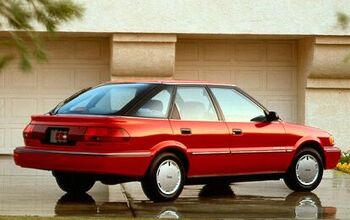QOTD: Automotive Facelifts Done Right?

In last Wednesday’s Question of the Day post, we discussed vehicles ruined by the facelifts foisted upon them by their manufacturers. This week we will flip the question around and consider the most successful examples of automotive nip/tucks; the ones subtle enough to look great, yet noticeable enough to catch a second glance.
One facelift in particular has always stood out to yours truly as a good example of how to do vehicular revision properly. Have a look:
This is, of course, the original Ford Flex, a model which met its end this year. What started out in 2010 as a new wagon-type crossover replacement for the outgoing Taurus X was modernized in 2013. New headlamps and a new grill accompanied restyled bumpers and new dark trim and wheel options. Changes took place on the inside too, with a new dashboard and steering wheel. As it aged, the Flex matured into a better-looking vehicle. It certainly stood in stark contrast to its Lincoln brother, the utterly horrible-looking MKT.
The Flex is a great example of how you can alter a car’s design without spending too many development dollars, resulting in a vehicle that’s better looking and more modern than the outgoing version. Let’s hear your selections for those automotive facelifts done right.
[Images: Ford]

Interested in lots of cars and their various historical contexts. Started writing articles for TTAC in late 2016, when my first posts were QOTDs. From there I started a few new series like Rare Rides, Buy/Drive/Burn, Abandoned History, and most recently Rare Rides Icons. Operating from a home base in Cincinnati, Ohio, a relative auto journalist dead zone. Many of my articles are prompted by something I'll see on social media that sparks my interest and causes me to research. Finding articles and information from the early days of the internet and beyond that covers the little details lost to time: trim packages, color and wheel choices, interior fabrics. Beyond those, I'm fascinated by automotive industry experiments, both failures and successes. Lately I've taken an interest in AI, and generating "what if" type images for car models long dead. Reincarnating a modern Toyota Paseo, Lincoln Mark IX, or Isuzu Trooper through a text prompt is fun. Fun to post them on Twitter too, and watch people overreact. To that end, the social media I use most is Twitter, @CoreyLewis86. I also contribute pieces for Forbes Wheels and Forbes Home.
More by Corey Lewis
Latest Car Reviews
Read moreLatest Product Reviews
Read moreRecent Comments
- Probert They already have hybrids, but these won't ever be them as they are built on the modular E-GMP skateboard.
- Justin You guys still looking for that sportbak? I just saw one on the Facebook marketplace in Arizona
- 28-Cars-Later I cannot remember what happens now, but there are whiteblocks in this period which develop a "tick" like sound which indicates they are toast (maybe head gasket?). Ten or so years ago I looked at an '03 or '04 S60 (I forget why) and I brought my Volvo indy along to tell me if it was worth my time - it ticked and that's when I learned this. This XC90 is probably worth about $300 as it sits, not kidding, and it will cost you conservatively $2500 for an engine swap (all the ones I see on car-part.com have north of 130K miles starting at $1,100 and that's not including freight to a shop, shop labor, other internals to do such as timing belt while engine out etc).
- 28-Cars-Later Ford reported it lost $132,000 for each of its 10,000 electric vehicles sold in the first quarter of 2024, according to CNN. The sales were down 20 percent from the first quarter of 2023 and would “drag down earnings for the company overall.”The losses include “hundreds of millions being spent on research and development of the next generation of EVs for Ford. Those investments are years away from paying off.” [if they ever are recouped] Ford is the only major carmaker breaking out EV numbers by themselves. But other marques likely suffer similar losses. https://www.zerohedge.com/political/fords-120000-loss-vehicle-shows-california-ev-goals-are-impossible Given these facts, how did Tesla ever produce anything in volume let alone profit?
- AZFelix Let's forego all of this dilly-dallying with autonomous cars and cut right to the chase and the only real solution.




































Comments
Join the conversation
Jaguar XJS. I thought the 93-96 cars looked much more modern and cleaner, yet the changes were relatively cheap and minor - bumpers and taillights. The interior was revised too, nicer gauges and seats.
Previous gen Explorer. The 2011 generation had a very soft and busy front end and no cohesiveness with the tailights, while the 2016 refresh brought a more SUV-like handsome front end and matched better with the profile and back. Also the 2017 Escape refresh was a nice one. As a former owner of a 2008 I was so pissed when I saw that tall Focus unveiled as a 2013 Escape. Both the front and and tailights where hideous but corrected in 2017